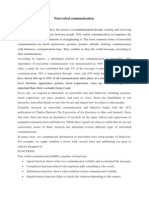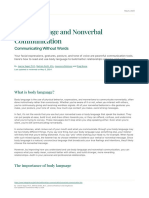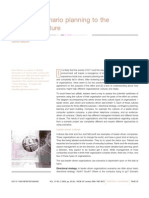Sami Bhai
Sami Bhai
Uploaded by
Nostalgic IlluzionsCopyright:
Available Formats
Sami Bhai
Sami Bhai
Uploaded by
Nostalgic IlluzionsOriginal Title
Copyright
Available Formats
Share this document
Did you find this document useful?
Is this content inappropriate?
Copyright:
Available Formats
Sami Bhai
Sami Bhai
Uploaded by
Nostalgic IlluzionsCopyright:
Available Formats
To
Mr Mustanir M Lodhi
By
M Sami Ur Rehman
Non verbal
communication
CommunlcaLlon skllls
asslgnmenL
Sam| ur rehman
3]11]2011
-n verba| Cmmun|cat|n
Nonverbal communication, or body language, is a vital form of
communication. When we interact with others, we continuously
give and receive countless wordless signals. All of our nonverbal
behaviors-the gestures we make, the way we sit, how fast or
how loud we talk, how close we stand, how much eye contact we
make-send strong messages.
The way you listen, look, move, and react tell the other person
whether or not you care and how well youre listening. The
nonverbal signals you send either produce a sense of interest,
trust, and desire for connection-or they generate disinterest,
distrust, and confusion.
DLII-I1IC-
A significant amount of the communication that goes on between people is
non-verbal. Although most people do not realize it, and more cannot pick
up on it, people are constantly using their bodies to send signs to each
other. These signs can indicate what they are truly feeling at the time or
they can be misinterpreted by the other person and misunderstanding can
result. Thus, understanding your body language and correctly reading the
body language of others can be critical in effective communication.
Characteristic
1. Non-verbal messages primarily communicate emotions, attitudes.
2. Non-verbal cues substitute for, contradict, emphasize or regulate
verbal message.
. Non-verbal cues are often ambiguous.
4. Non-verbal cues are continuous.
5. Non-verbal cues are more reliable.
6. Non-verbal cues are culture bound.
7. Non-verbal behavior always has communicative value.
Non-verbal communication is powerful.
%5e of non verbaI communication:
There are many different types of nonverbal communication. Together, the
following nonverbal signals and cues communicate your interest and
investment in others.
Facial expressions
The human face is extremely expressive, able to express countless emotions
without saying a word. And unlike some forms of nonverbal communication,
facial expressions are universal. The facial expressions for happiness,
sadness, anger, surprise, fear, and disgust are the same across cultures.
Body movements and posture
Consider how your perceptions of people are affected by the way they sit,
walk, stand up, or hold their head. The way you move and carry yourself
communicates a wealth of information to the world. This type of nonverbal
communication includes your posture, bearing, stance, and subtle
movements.
Gestures
Gestures are woven into the fabric of our daily lives. We wave, point,
beckon, and use our hands when were arguing or speaking animatedly-
expressing ourselves with gestures often without thinking. However, the
meaning of gestures can be very different across cultures and regions, so its
important to be careful to avoid misinterpretation.
Eye contact
Since the visual sense is dominant for most people, eye contact is an
especially important type of nonverbal communication. The way you look at
someone can communicate many things, including interest, affection,
hostility, or attraction. Eye contact is also important in maintaining the flow
of conversation and for gauging the other persons response.
%ouch
We communicate a great deal through touch. Think about the messages
given by the following: a firm handshake, a timid tap on the shoulder, a
warm bear hug, a reassuring pat on the back, a patronizing pat on the head,
or a controlling grip on your arm.
Space
Have you ever felt uncomfortable during a conversation because the other
person was standing too close and invading your space? We all have a need
for physical space, although that need differs depending on the culture, the
situation, and the closeness of the relationship. You can use physical space
to communicate many different nonverbal messages, including signals of
intimacy, aggression, dominance, or affection.
Voice
We communicate with our voices, even when we are not using words.
Nonverbal speech sounds such as tone, pitch, volume, inflection, rhythm,
and rate are important communication elements. When we speak, other
people "read our voices in addition to listening to our words. These
nonverbal speech sounds provide subtle but powerful clues into our true
feelings and what we really mean. Think about how tone of voice, for
example, can indicate sarcasm, anger, affection, or confidence.
Interpret|ng nn verba| messages
s there ever any doubt in your mind as to the mood oI a coworker upon their
arrival at work? Nonverbal communication is the single most powerIul Iorm oI
communication. More than voice or even words, nonverbal communication cues
you in to what is on another person`s mind. The best communicators are sensitive
to the power oI the emotions and thoughts communicated nonverbally.
Nonverbal communication ranges Irom Iacial expression to body language.
Gestures, signs, and use oI space are also important in nonverbal communication.
Multicultural diIIerences in body language, Iacial expression, use oI space, and
especially, gestures, are enormous and enormously open to misinterpretation.
In an organization
To ensure successful communications within your organization, it is best to
start with the very basics: your knowledge of verbal and non-verbal
communications. n the workplace, these types of communications are
continually exchanged, oftentimes without much planning or even the
thought that such communications are taking place.
iving Peo5Ie %ime
$etting aside a specific time for meetings and regular communications is a
great idea. This allows time for everyone involved to prepare. Also, keep in
mind that listening is oftentimes much more productive when working to
communicate effectively, and can very well be more important than talking.
Allow everyone involved the time they need to communicate effectively.
Enhancing Your Communications
O Because gestures can both compliment and contradict your message, be
mindIul oI these.
O ye contact is an important step in sending and receiving messages. ye
contact can be a signal oI interest, a signal oI recognition, even a sign oI
honesty and credibility.
O losely linked to eye contact are Iacial expressions, which can reIlect
attitudes and emotions.
O !osture can also be used to more eIIectively communicate your message.
O lothing is important. By dressing Ior your job, you show respect Ior the
values and conventions oI your organization.
O Be mindIul oI people`s personal space when communicating. Do not
invade their personal space by getting too close and do not conIuse
communications by trying to exchange messages Irom too Iar away.
1|ps fr effect|ve use f n|n verba|
cmmun|cat|n
hether at a huge political rally or homeowner's association meeting, reverential
anticipatory silence is oIIered to very Iew. Much oI your success in getting a
group's attention and keeping it hinges on your skill with non-verbal
communication rather than what you have to say. Use appropriate visual coding as
well as the right verbal conventions to increase your chances oI successIul
communication.
S1L U
n many cultures, slouching is considered a sign oI disrespect. n estern culture it
telegraphs that the speaker is not engaged in his task. Sit or stand straight beIore
speaking; imagine a string that pulls right up your backbone. !ay physical attention
to the speaker who precedes you by watching; listen Ior the audience's reactions to
get a "sense oI the room" but don't watch them. ear business dress Ior most
public speaking; it is universally recognized and shows that the speaker takes his
task--and his audience---seriously. hen it's time to speak, stand up straight, hold
your head up and speak up; you know more about your subject than most oI your
audience.
LkkLSSIC-S
Once at the podium, address your audience with your eyes beIore speaking to let
them know that they, not your notes, are your Iocus. Use active eye contact; move
Irom person to person, involving but not intimidating individuals. Michael .
orbalis maintains that language may have evolved Irom gestures, making them an
integral part oI any spoken words. Today's audiences, however, are accustomed to
subtle television-sized gestures. According to harles Tidwell at Andrews
University, women smile more than men; both should limit smiles because they
may be interpreted as artiIiciality. Use nods, Iacial expressions and hand gestures
to accent, reinIorce or complement messages. Nods or gestures should emphasize
or move attention to, say, visual aids. Too many Iacial expressions or hand
gestures telegraph distraction or lack oI preparation.
-CW AUDIL-CL
ou don't have to know every individual in the audience but you do need to respect
general cultural conventions with the group. Deals have been broken and clients
lost because oI a gesture with a negative cultural meaning. Don't attempt to remake
yourselI in what you think is their image; just stay away Irom gestures that might
be interpreted as negative. Robert Like advises health care providers to avoid
prolonged direct eye contact with any individual in an Asian audience but that eye
contact is imperative with Latin Americans. !ointing with the index Iinger is rude
in some cultures. The "OK" sign with thumb and IoreIinger is considered the sign
Ior money in Japan but it is an obscene gesture in some astern uropean
countries. n Latin America shrugging with palms up can be a vulgar gesture.
Avoid using gestures that have negative meanings in other cultures as a matter oI
habit; that way, you won't make a mistake when you actually address or present to
a group with members Irom another culture.
1ne
Tone oI voice is a powerIul aspect oI message delivery. I you say the words "'m
so happy to see you" through gritted teeth, the other person will inIer a diIIerent
message Irom your tone than the words themselves suggest. Regardless oI the
words you say, your tone can imply disdain, anger, happiness or any other emotion.
Cntrad|ctry 8ehav|rs
According to Help Guide, nonverbal communication should reinIorce the words
someone is saying. n many cases, a person might say one thing and his body
language might say something else. Observe the other person's tone, gestures,
posture and eye contact to determine whether it matches his message. Awareness
oI contradictory words and behaviors can lead to greater understanding oI a
situation.
When In Dubt Ask
Though there are common interpretations oI nonverbal cues, nonverbal behaviors
do not have Iixed meanings. hen mixed messages Irom someone result in
conIusion about what she is trying to express, ask her to clariIy. Use phrases such
as "As you see it..." or " get the impression that..." and repeat the other person's
basic message to her. This gives her the chance to conIirm or clariIy the message.
Summary
!eople react to the unspoken, as much (iI not more) to how something is said as to
what are the explicit meaning oI the words. Misunderstandings can oIten be
clariIied iI the people involved have the ability to notice and comment on the
nonverbal communications in an interaction. !eople will beneIit Irom learning the
range oI nonverbal behaviors in order to clariIy the oIten subtle dynamics oI the
situations they Iind themselves in. For example, in a marriage, sometimes the other
person gets irritated by some mysterious event: xploring what was the problem
may lead to an awareness that the way something was said communicated an
unintended meaning! By making the nonverbal communication more clear,
misunderstandings can be resolved.
You might also like
- CS3 - The Management Control Freak FinalDocument3 pagesCS3 - The Management Control Freak FinalPiero Di Fede100% (2)
- Nonverbal Communication 3Document44 pagesNonverbal Communication 3Muhammad Adnan TayyabNo ratings yet
- Importance of Body Language in CommunicationDocument14 pagesImportance of Body Language in CommunicationSajad Azeez80% (5)
- The Importance of Non Verbal ComunicationDocument8 pagesThe Importance of Non Verbal ComunicationLeonardo UrraNo ratings yet
- Nonverbal Communication Referat EnglezaDocument6 pagesNonverbal Communication Referat EnglezaIoanaMariaGavrilaNo ratings yet
- Character in Modernist and Post Modernist LiteratureDocument2 pagesCharacter in Modernist and Post Modernist Literaturemoniquemozard100% (1)
- Nimrods, Piscators, Pluckers, and Planters:The Emergence of Food Production by Brian Hayden 1990Document39 pagesNimrods, Piscators, Pluckers, and Planters:The Emergence of Food Production by Brian Hayden 1990beardo18No ratings yet
- Morphological Analysis of IndonesianDocument12 pagesMorphological Analysis of IndonesianViciAlfananiNo ratings yet
- Tuscan ColumnsDocument6 pagesTuscan ColumnsAlexLionNo ratings yet
- Sounds, Words, or Speaking. The Tone, Volume, and Pitch of One's Voice Can All Contribute To Effective Verbal CommunicationDocument4 pagesSounds, Words, or Speaking. The Tone, Volume, and Pitch of One's Voice Can All Contribute To Effective Verbal CommunicationJhustie Mae CruzNo ratings yet
- ProjectDocument21 pagesProjectNiko BellicNo ratings yet
- Nonverbal CuesDocument8 pagesNonverbal CuesHassam KhokharNo ratings yet
- Body LanguageDocument3 pagesBody LanguageAnjaliNo ratings yet
- BC Unit 3Document3 pagesBC Unit 3RISHI SABOONo ratings yet
- Non - Verbal Communication - PPT DraftDocument21 pagesNon - Verbal Communication - PPT DraftlawrencekellyNo ratings yet
- Skip To Content-WPS OfficeDocument76 pagesSkip To Content-WPS OfficeRhealyn MalanoNo ratings yet
- HLM 10Document8 pagesHLM 10shobirinNo ratings yet
- Non-Verbal CommunicationDocument21 pagesNon-Verbal Communicationgabrielle100% (1)
- Verbal and Non - VerbalDocument9 pagesVerbal and Non - VerbalBenedict Lizardo MaddaraNo ratings yet
- Definitions of Nonverbal CommunicationDocument3 pagesDefinitions of Nonverbal CommunicationBloodless Khan100% (1)
- Intercultural Business ComunicationDocument18 pagesIntercultural Business ComunicationIon GondobescuNo ratings yet
- ENG301 Assignment#2 Solution by AsadMunirDocument5 pagesENG301 Assignment#2 Solution by AsadMunirAzan MalikNo ratings yet
- Nonverbal CommunicationDocument5 pagesNonverbal CommunicationFahadKhanNo ratings yet
- Business CommunicationDocument8 pagesBusiness CommunicationVictor Batu DanboyiNo ratings yet
- C4 Effective Bodily Actions Gestures - Naomi LopezDocument37 pagesC4 Effective Bodily Actions Gestures - Naomi LopezNolan G. SerranoNo ratings yet
- Non-Verbal CommunicationDocument7 pagesNon-Verbal CommunicationSiddh Bhatt100% (2)
- Nonverbal Communication and Body LanguageDocument9 pagesNonverbal Communication and Body LanguagepagaluNo ratings yet
- Body Language ReportDocument7 pagesBody Language ReportBarn BeanNo ratings yet
- BCOMDocument15 pagesBCOMAnkita SinghNo ratings yet
- Decoding Non-Verbal Communication: January 2011Document9 pagesDecoding Non-Verbal Communication: January 2011gymvideoNo ratings yet
- Verbal Non Verbal Group 2Document10 pagesVerbal Non Verbal Group 2arga fikriNo ratings yet
- Notes On Unit 2 BtechDocument11 pagesNotes On Unit 2 BtechusethisidonlyforwebsitesNo ratings yet
- Nonverbal Communication and Body LanguageDocument6 pagesNonverbal Communication and Body LanguageAhmad BassamNo ratings yet
- Business Communication AssignmentDocument5 pagesBusiness Communication Assignmentsahil_ahuja_10No ratings yet
- Class 3Document20 pagesClass 3Vinmathi AnugrahaNo ratings yet
- Non-Verbal CommunicationDocument15 pagesNon-Verbal CommunicationKrunal SojitraNo ratings yet
- Body Language and Nonverbal CommunicationCommunicating Without WordsDocument6 pagesBody Language and Nonverbal CommunicationCommunicating Without WordsAnna SzklarzNo ratings yet
- Communication SkillsDocument63 pagesCommunication SkillsLalita SubrahmanyamNo ratings yet
- Soft Skills and Interpersonal CommunicationDocument20 pagesSoft Skills and Interpersonal Communicationradhemadhav0907No ratings yet
- ASSIGNMENT 2.doxDocument7 pagesASSIGNMENT 2.doxRhea JacobNo ratings yet
- Why Does Nonverbal Communication MatterDocument2 pagesWhy Does Nonverbal Communication Matternguyễnthùy dươngNo ratings yet
- Soc PsychologyDocument73 pagesSoc PsychologyRavisankar ThiagarajanNo ratings yet
- Effective Communication: Helping Families & Friends Find Better WaysDocument4 pagesEffective Communication: Helping Families & Friends Find Better WaysMesbaul KhairNo ratings yet
- Nonverbal CommunicationDocument8 pagesNonverbal CommunicationRessieCabaneroNo ratings yet
- HarrishDocument3 pagesHarrishPretika IndranNo ratings yet
- Group 5 - CCDocument17 pagesGroup 5 - CCKeeganNo ratings yet
- Verbal and Non Verbal Communication 2019Document29 pagesVerbal and Non Verbal Communication 2019Russel Jil Gonzales100% (3)
- Verbal and Non Verbal Emotional and Conversational MessagesDocument5 pagesVerbal and Non Verbal Emotional and Conversational MessagesHumayun KhanNo ratings yet
- CC ComDocument8 pagesCC ComTANNANo ratings yet
- Body LanguageDocument14 pagesBody LanguageMeriemNo ratings yet
- Role of Non-Verbal LanguageDocument31 pagesRole of Non-Verbal LanguageSuman MaharjanNo ratings yet
- 000000000examples of Non Verbal CommunicationDocument4 pages000000000examples of Non Verbal CommunicationAngie MandeoyaNo ratings yet
- Project Report On GesturesDocument27 pagesProject Report On GesturesRaghavWattsNo ratings yet
- Nonverbal Communication (BAS105 UNIT-4)Document16 pagesNonverbal Communication (BAS105 UNIT-4)sachinnonofficialmailNo ratings yet
- Types of Nonverbal Communication and Body LanguageDocument2 pagesTypes of Nonverbal Communication and Body LanguageFiona O' ConnorNo ratings yet
- Body LanguageDocument3 pagesBody LanguageshraddhaNo ratings yet
- 17th-Week 6 Non Verbal CommunicationDocument35 pages17th-Week 6 Non Verbal Communicationsamuelmwangome03No ratings yet
- Prof.A.adhave For Her Kind Support. We Are Grateful To: AcknowledgementDocument16 pagesProf.A.adhave For Her Kind Support. We Are Grateful To: AcknowledgementVaibhav JadhavNo ratings yet
- Buscom ReviewerDocument18 pagesBuscom ReviewerTrixia AbelitaNo ratings yet
- Nonverbal CommunicationDocument6 pagesNonverbal CommunicationAdriana CalinoiuNo ratings yet
- Ehab Etman 5484Document5 pagesEhab Etman 5484Ehab EtmanNo ratings yet
- Week 5 Nonverbal CommunicationDocument6 pagesWeek 5 Nonverbal CommunicationGhina JinanNo ratings yet
- Body Language: Learn How to Talk to Anyone, Master Nonverbal Communication, Analyze People, and Decode Human Behavior to Protect Yourself Against Dark Psychology, Manipulation, and NLP.From EverandBody Language: Learn How to Talk to Anyone, Master Nonverbal Communication, Analyze People, and Decode Human Behavior to Protect Yourself Against Dark Psychology, Manipulation, and NLP.No ratings yet
- The Art of Non-Verbal Communication - Understanding What People Aren’t SayingFrom EverandThe Art of Non-Verbal Communication - Understanding What People Aren’t SayingNo ratings yet
- Black Viewpoint PDFDocument57 pagesBlack Viewpoint PDFnsovosamboNo ratings yet
- Business Is Business?: Communicating Across Business CulturesDocument10 pagesBusiness Is Business?: Communicating Across Business CulturesSao NguyễnNo ratings yet
- Tailoring Scenario Planning To The Company Culture: David MasonDocument4 pagesTailoring Scenario Planning To The Company Culture: David MasonShaffri SabriNo ratings yet
- Chinese Culture and CustomsDocument32 pagesChinese Culture and CustomsEzgamApeNo ratings yet
- Synchronous GrowthDocument2 pagesSynchronous Growthsaahiba16100% (6)
- Indianization Debate: Historiography and Debates On South East Asian Cultural FormationsDocument8 pagesIndianization Debate: Historiography and Debates On South East Asian Cultural FormationsSantosh Kumar MamgainNo ratings yet
- 32626959Document2 pages32626959mohamedamineomar2007No ratings yet
- Metallica BiographyDocument5 pagesMetallica Biographymadi leeNo ratings yet
- Unit 03 - PATHWAYS 2 - Listening, Speaking and Critical Thinking PDFDocument20 pagesUnit 03 - PATHWAYS 2 - Listening, Speaking and Critical Thinking PDFTaylor Nhật0% (1)
- FruchterDocument3 pagesFruchterhaltovskyNo ratings yet
- Mercy Brown Vampire IncidentDocument3 pagesMercy Brown Vampire IncidentValentin MateiNo ratings yet
- The Weekly - Phnom Penh January 13Document12 pagesThe Weekly - Phnom Penh January 13James100% (1)
- Predicting The Priorities of Multicultural Education in A Philippine Teacher Education Institution: An Exploratory StudyDocument10 pagesPredicting The Priorities of Multicultural Education in A Philippine Teacher Education Institution: An Exploratory StudyHaydee UmandalNo ratings yet
- The 1000 Most: Common SATDocument70 pagesThe 1000 Most: Common SATEvan WilsonNo ratings yet
- Chhamak Chhoriyan Se Nayanwa Ladawat Wat Wat Lyrics Translation TamashaDocument3 pagesChhamak Chhoriyan Se Nayanwa Ladawat Wat Wat Lyrics Translation TamashadkshtdkNo ratings yet
- A Detailed Lesson Plan in Ge8 EthicsDocument20 pagesA Detailed Lesson Plan in Ge8 EthicsAdrian AbadNo ratings yet
- Anzaldúa - La Conciencia de La MestizaDocument11 pagesAnzaldúa - La Conciencia de La MestizaOlga Rodríguez UlloaNo ratings yet
- System of The Modern Roman Law PDFDocument403 pagesSystem of The Modern Roman Law PDFNaman DadhichNo ratings yet
- Iol 2023 Team Prob - enDocument12 pagesIol 2023 Team Prob - enTan Yu XuanNo ratings yet
- British Colonial Architecture PDFDocument226 pagesBritish Colonial Architecture PDFthemathlover0% (1)
- Practice Tests From The University of Cambridge Local Examinations SyndicateDocument18 pagesPractice Tests From The University of Cambridge Local Examinations SyndicateMonica IorgulescuNo ratings yet
- Life and Works of Rizal Zaide Chapter 1 SummaryDocument5 pagesLife and Works of Rizal Zaide Chapter 1 SummaryLyka Jocel CorpuzNo ratings yet
- SMSW NSWTDocument17 pagesSMSW NSWTdstefano9No ratings yet
- Paginas de Novelas-1Document21 pagesPaginas de Novelas-1José ApazaNo ratings yet
- The Study of CultureDocument10 pagesThe Study of CultureKeneth NagumNo ratings yet

























































































